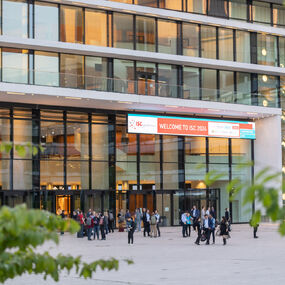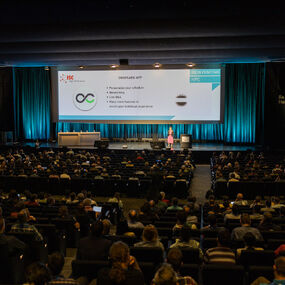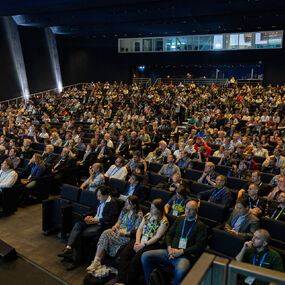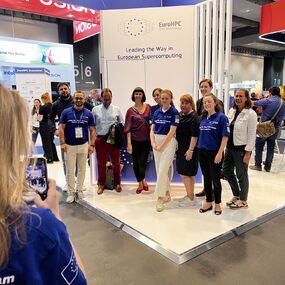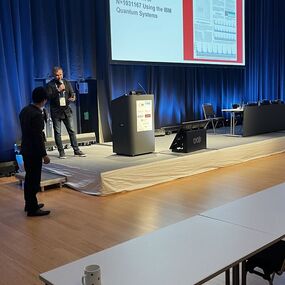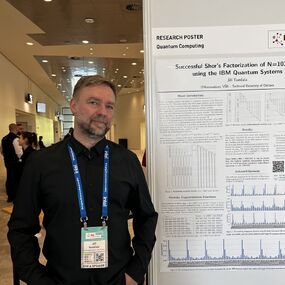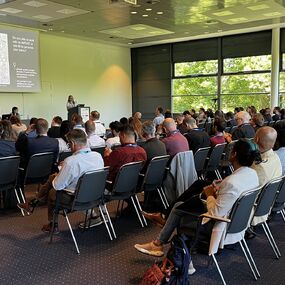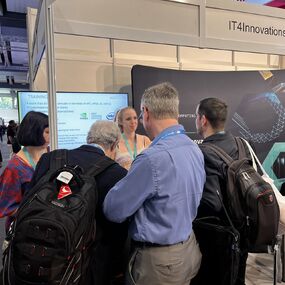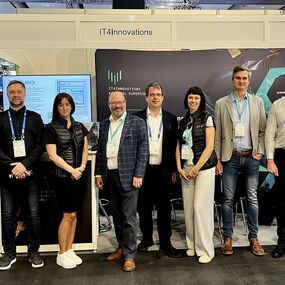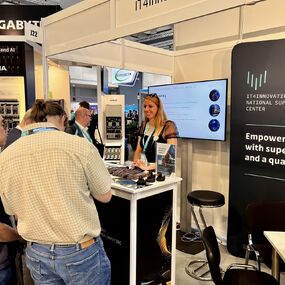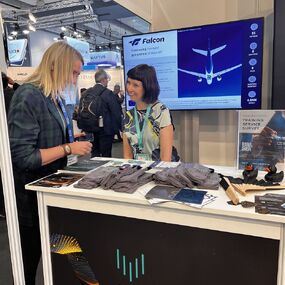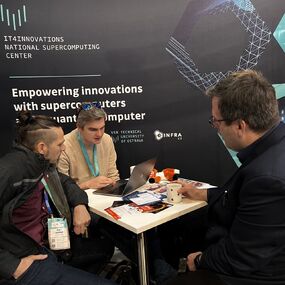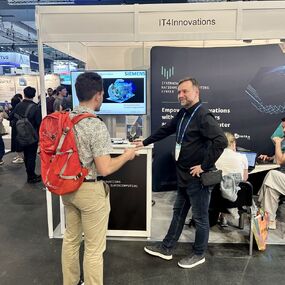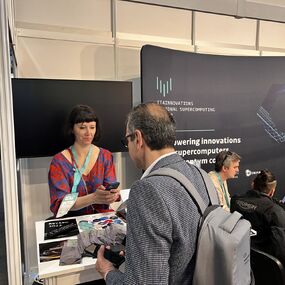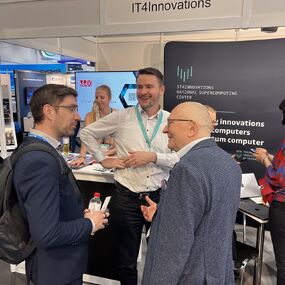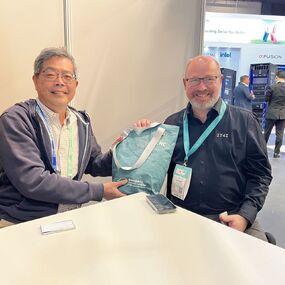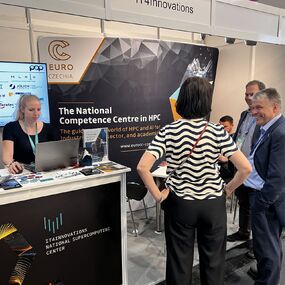The world's oldest and Europe's most important HPC conference – ISC High Performance – was held in Germany. Its history dates back more than 30 years. IT4Innovations National Supercomputing Center had its first booth at this conference in Leipzig in 2014.
More than 3,400 scientists, representatives of supercomputing centres, companies, and HPC enthusiasts from 52 countries gathered at the Congress Center Hamburg over five days to present their research and technological advances not only in the fields of high-performance computing, machine learning, and data analysis but also quantum computing. The theme of this year's conference was "Reinventing HPC" and emphasised the need for a new perspective on high-performance computing. As Moore's Law slows down and the cost of transistors rises, it is essential to consider how to make HPC efficient. Integrating AI and quantum computing-based applications is a key direction for further development of high-performance computing. These two technologies can significantly push the boundaries of what is possible in HPC.
Jiří Tomčala from the Quantum Computing Lab presented his research on "Successful Shor's Factorization of N=1031167 using the IBM Quantum Systems" at the poster session of the conference and added: "This year's ISC conference was marked by the rise of quantum technologies. The established companies with the most widely used superconducting quantum computers were joined by companies working on quantum computers with qubits based on trapped ions, photons, and neutral atoms. This diversity is a clear sign that the field is booming, which is nothing but good news for those like me who program quantum computers. A related point is that several months-old results I presented in my research poster could already be obtained with greater precision today. However, the fact that it also describes the successful factorisation of the largest number on a quantum computer has impressed insiders. While they took pictures of it, we discussed the possibility of building a general factorisation quantum circuit for quantum computers yet to come."
At the ISC 2024 Conference exhibition, IT4Innovations presented its activities, including the National Competence Centre in HPC and the international projects it is currently working on. Sharing news and experience with the HPC community creates new opportunities, discussions, inspiration, and the opportunity to meet outstanding personalities.
At the ISC High Performance Conference, Karina Pešatová, Head of Training and Education Department, participated in several Birds-of-a-Feather sessions. In the "HPC Outreach: Telling Our Stories of HPC in Science" session, Karina Pešatová joined speakers such as Weronika Filinger and Eleanor Broadway from the Scottish Supercomputing Centre EPCC, Cristin Merritt from Alces Flight in the UK, and Jane Herriman from Lawrence Livermore National Laboratory in the USA. They discussed best practices for presenting HPC achievements and how to communicate complex scientific concepts to the general public effectively. In the "Super(computing)heroes" session, Karina Pešatová and other women from the HPC community discussed the challenges and achievements of women in the field. They provided inspirational advice to young female professionals. In the interactive "HPC and You v4.0 ¬- a Student BoF on Enjoying a Career and Community in HPC" session, together with Andrea Townsend-Nicholson from Univesity College London, Volker Weinberg from the Leibniz Supercomputing Centre, and Georg Zitzlsberger from NVIDIA, she introduced students and young professionals to career opportunities in HPC, training programmes available and other opportunities to get involved in the HPC community.
During the conference, the updated TOP500 list of the world's most powerful supercomputers was announced. First and second place were taken by the US National Laboratories' exascale supercomputers. For two years, the US Frontier system has held first place (installed at Oak Ridge National Laboratory, theoretical peak performance of 1.71 EFlop/s), which also has impressive energy efficiency - ranked 13th in the GREEN500 list. The second place was taken by the Aurora supercomputer from Argonne National Laboratory and the third place goes to Microsoft Azure's Eagle.
All EuroHPC Joint Undertaking supercomputers, including the Karolina supercomputer at IT4Innovations, are featured in the TOP500 list and ranked among the 226 best supercomputers in the world.
Three EuroHPC JU preexascale supercomputers remain in the top ten of TOP500 (LUMI, Leonardo, and MareNostrum5). Europe's first exascale supercomputer, JUPITER, is already setting new standards in energy efficiency. Its JEDI module has been ranked first in the Green500 list. With its GPU-accelerated partition, the Karolina supercomputer is currently ranked 36th in Green500.
Being part of this conference inspires us as it allows us to maintain important contacts, establish new collaborations, and see the latest innovations firsthand. This year's edition was once again full of fascinating lectures and presentations that provided us with valuable insights and suggestions for further developing our projects. We are proud to represent IT4Innovations on such an important platform and to contribute to the advancement of high-performance computing, machine learning, data analytics, and quantum computing.
Two years ago, discussions were initiated to get the HPC community to acknowledge that high-performance computing was at a crossroads and needed to look beyond exascale supercomputers. This year, participants debated ways to connect HPC with cloud computing, artificial intelligence, quantum computing, and other innovative technologies. Therefore, the 40th anniversary edition of the conference in 2025 will be held under the "Connecting the Dots" slogan.
Torsten Hoefler, Programme Chair of ISC 2025, adds to this slogan: “The theme will be networking. This includes the connections between the different fields such as HPC, AI, cloud and quantum computing that are currently being reinvented and connections between people, companies, universities, and the new generation of HPC talents. Our field is essentially the science of connections - we connect transistors to make processors and memories, which we then connect to compute nodes. At the highest level, we connect them with HPC networks to create clusters and supercomputers.
Just as we connect machines, we need to connect people across generations – from university students to senior politicians and decision-makers in business and government."

